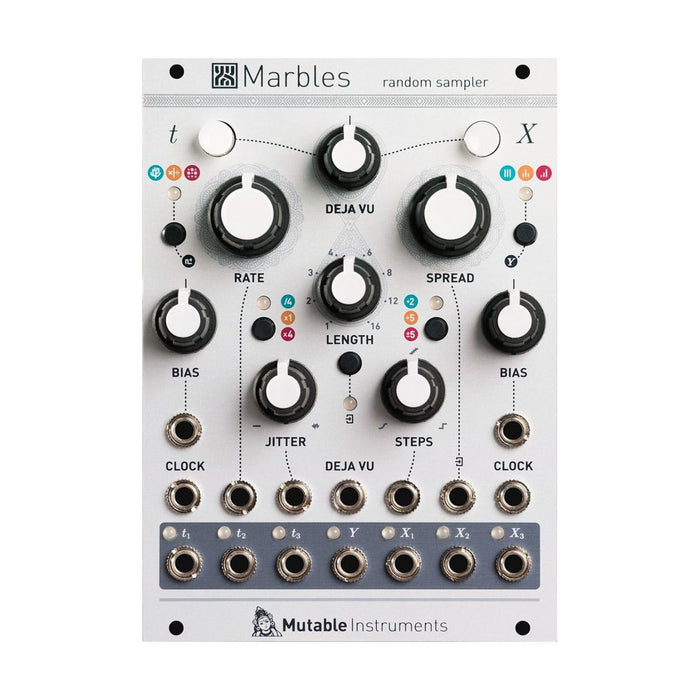Marbles is a random gate CV generator with many outputs and CV inputs. The output random voltage can be limited in various ways (eg synchronization with an external clock, repetition frequency or rare event occurrence, traditional staircase random voltage, etc.).
t section: random gate generator
The t section outputs a random gate sequence clock. This section uses an internal clock or an external clock that is an integer multiple faster or slower (divide / multiplication) to create a clock containing an error and use it as a master. The error is a deviation from the rhythm of the musician who plays by listening to the click, a movement that recovers from there, and it is possible to continuously control from 100% accurate clock to completely random ((
JitterControl).
The master clock generated in this way is output from t2. The gate algorithm output from t1 and t3 is the left of the Rate knob.
t Section mode selection buttonCan be selected with, and can be selected from the following
- ・ Algorithm to decide gate ON / OFF like random coin toss (Branchesthe same as). Bias introduces a bias in the probability of gate appearance from t1 and t3
- -Random divide and multiplication algorithms. Bias controls the divide and multiplication factors.
- ・ Algorithm that switches the output of t1 and t3 with a pattern combination such as kick and snare (Gridsthe same as). Bias controls the pattern
Gate length
t Section mode selection buttonIt can be controlled by turning Bias while pressing. Also
t Section mode selection buttonBy turning the Jitter while pressing, the output gate length changes randomly, and the degree can be controlled.
X Section: Random CV Generator
In this section, a random CV clocked by the corresponding t output (or the external clock common to the X section) is output from X1 to X3. The random voltage that is output can be controlled in various ways with the following controls. To see how they respond to these controls,
X section mode switch buttonIt is possible to switch with (X1 to X3 are all panel control / X2 is panel control, X1 and X3 are control and opposite settings / X3 is control opposite, X1 is exact opposite setting, X2 is knob in the middle Setting).
The stochastic distribution shape of voltage is
spreadUse the knob / CV to control. The knob outputs the constant voltage at the leftmost position, and when it is turned to the right, the voltage is output according to the probability distribution that the voltage becomes the center peak. When the knob is at 12 o'clock, the distribution has a bell shape, and if you turn it to the right, the probability of appearance of the value at the end away from the center increases. When turned all the way to the right, either the minimum value or the maximum value of the range is output, so the gate signal is output. The center of the distribution is the X section
biasControlled by. The range can be selected from 0 to + 2V, 0 to + 5V, -5 to + 5V with the range setting button.
The shape of the output voltage is
STEPSIt can be controlled with. When STEPS is at 12 o'clock, a step-like random voltage is output through only normal sample and hold.As you turn it to the right, the output voltage is quantized, and only the root note (integer volt) is output when it is full to the right.In the meantime, only the notes in the middle scale pass, and the scale can be set by pressing and holding the voltage range button. When STEPS is in the left position from 12 o'clock, it becomes a through voltage that smoothes the step-like change.
By holding down the voltage range button for 2 seconds, you can switch the scale at which the output voltage is quantized. Press and hold the button for 2 seconds, then press it a few more times to change the LED color and blinking speed:
- Slow blinking green: major
- Blinks orange slowly: Minor
- Slow blinking red: pentatonic
- Flashing green quickly: Gamelan
- Flashing orange quickly: Raag Bhairav
- Flashing red: Raag Shree
You can change these scales. Input the gate into Pitch CV and X Section clock from the keyboard or sequencer to Spread, and press the external processing mode button for 2 seconds. When you enter the scale you want to use in that state, Marbles analyzes it and overwrites the currently selected scale. Of the scales that are input, the one that is used the least frequently becomes the scale that is excluded when you turn Steps from the middle to the right.
The X output can also be used as a sample and hold for an external input voltage instead of a random voltage.To do this, press the button below Length
External voltage use modeToAt this time, the Spread CV input becomes the external voltage that is sampled and held.At this time, the operation is basically the same as when using the internal random voltage, but when the external clock is patched, the output of X1 to X3 will be the same if it is left as it is, so at this time the clock It functions as a shift register in which the sample & hold output moves from X1 to X2 to X3 each time.
Y section: Smooth random source
The Y output is a smooth random voltage from -2V to 1V that changes at a rate 16/5 that of X5. Spread on the right
X section mode switch buttonHolding down and turning the Rate, Spread, Bias, Steps knobs will change the corresponding parameters for the Y output.
Deja Vu control
The randomness of t section and X section is
Deja VuIt is possible to be affected by controls. The buttons on either side of the Deja Vu knob determine if each section is affected by the Deja Vu controls. Deja Vu is a control that mixes a loop-like structure with the output random voltage or random gate. For the t section and X section to which Deja Vu is assigned, the Deja Vu knob is set to the center to eliminate randomness in the output, and the most recent data for the specified number of steps will be output.
LengthLoop playback is performed for the amount specified in. When Dejavu is turned counterclockwise, the output changes gradually and randomly from the previous loop, and at the leftmost position, random numbers that are uncorrelated with past random values come out. If you turn it from the center to the right, the data picked up at random from the latest data for the specified step will be mixed and output.





